A Molecular Dynamics Study on Rotational Nanofluid and Its Application to Desalination
Abstract
1. Introduction
2. Results
2.1. Model Description
2.2. Motion of Water Molecules and Ions
2.3. Azimuthal Velocity and Boundary Slipping
2.4. Derivation of Centrifugal Pressure
2.5. Taylor Instability Due to High Rotational Flux
3. Discussion
4. Methods and Derivations
4.1. MD Simulation Details
4.1.1. Feed Flow Motion Solution Derived from Fluid Dynamics Theory
4.1.2. Comparisons between MD and Fluid Dynamics Theory
Author Contributions
Funding
Conflicts of Interest
Appendix A. Fluid Dynamics Solutions
Appendix A.1. Derivation of the Simplified Governing Equation (3) from the Navier-Stokes Equation
- Steady state:
- Homogeneous in and z direction (No gradient):
- Velocity in direction is much higher than z and r directions, i.e., , therefore it is assumed that .
Appendix A.2. Derivation of General Solutions (4) from N-S Equation
Appendix A.3. Solution of Equation (4) under Two Special Boundary Conditions Equations (5) and (6)
Appendix A.4. Derivation of the Critical Angular Velocity, ωcr:
Appendix B. Scale-Up Idea to Fabricate a Macroscale Nanoporous Rotating Centrifuge
- having a nano-porous membrane on the wall of the centrifuge;
- having a strong wall structure to support macroscale loads such as overall pressure under working conditions;
- having a realistic critical angular velocity of a few hundreds of radian per second to generate a centrifugal pressure that is greater than the osmosis pressure.
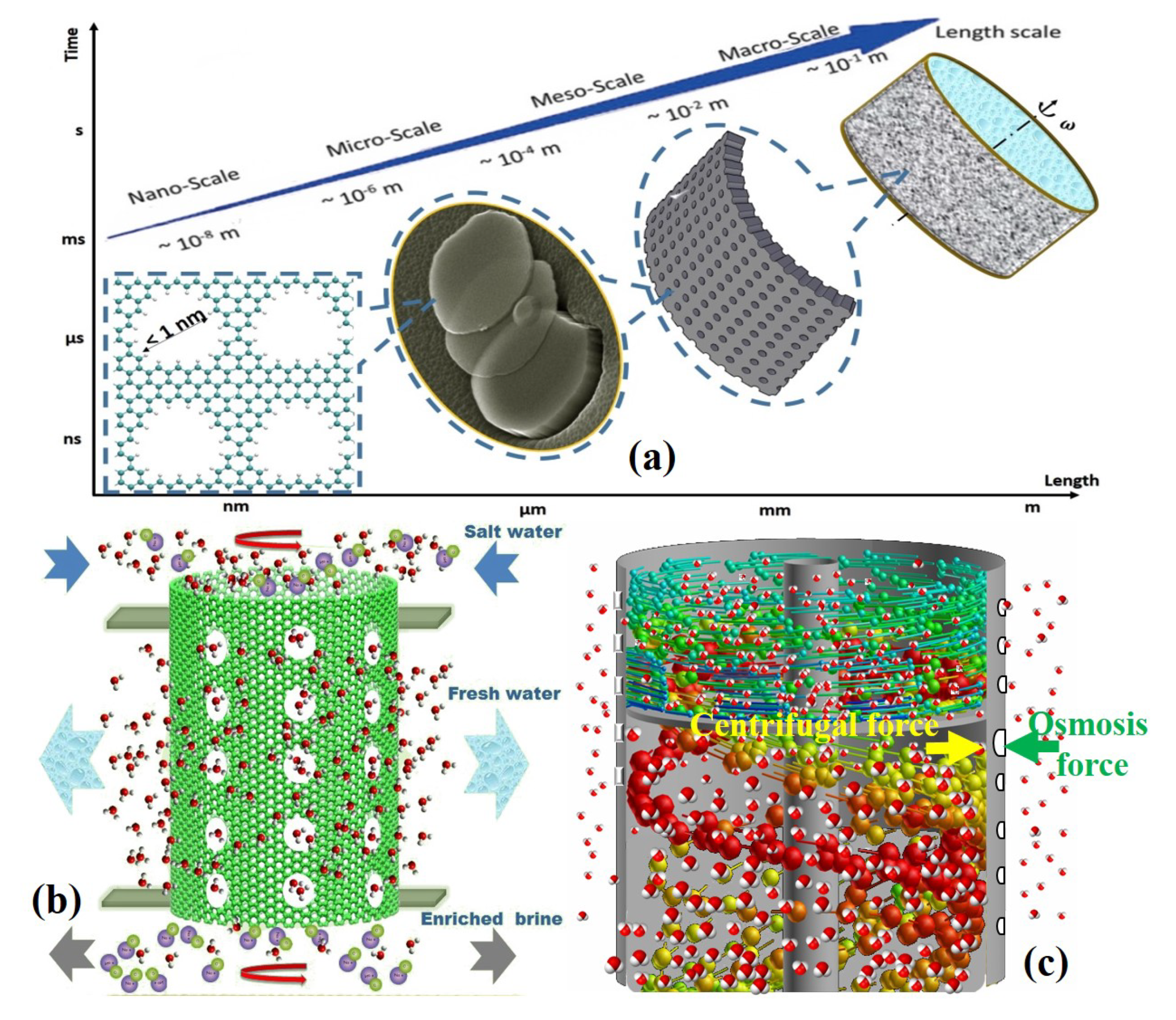
References
- Shannon, M.A.; Bohn, P.W.; Elimelech, M.; Georgiadis, J.G.; Marinas, B.J.; Mayes, A.M. Science and technology for water purification in the coming decades. Nature 2008, 452, 301–310. [Google Scholar] [CrossRef] [PubMed]
- Miller, J.E. Review of water resources and desalination technologies. In Sandia National Labs Unlimited Release Report SAND-2003-0800; Sandia National Laboratories: Albuquerque, NM, USA, 2003. [Google Scholar]
- Subramani, A.; Jacangelo, J.G. Emerging desalination technologies for water treatment: A critical review. Water Res. 2015, 75, 164–187. [Google Scholar] [CrossRef] [PubMed]
- El-Dessouky, H.; Ettouney, H.; Imad, A.; Ghada, A. Evaluation of steam jet ejectors. Chem. Eng. Process 2002, 41, 551–561. [Google Scholar] [CrossRef]
- Anderson, M.A.; Cudero, A.L.; Palma, J. Capacitive deionization as an electrochemical means of saving energy and delivering clean water. Comparison to present desalination practices: Will it compete? Electrochim. Acta 2010, 55, 3845–3856. [Google Scholar] [CrossRef]
- Hummer, G.; Rasaiah, J.; Noworyta, J. Water conduction through the hydrophobic channel of a carbon nanotube. Nature 2001, 414, 188–190. [Google Scholar] [CrossRef]
- Holt, J.K.; Park, H.G.; Wang, Y.; Stadermann, M.; Artyukhin, A.B.; Grigoropoulos, C.P.; Noy, A.; Bakajin, O. Fast mass transport through sub-2-nanometer carbon nanotubes. Science 2006, 312, 1034–1037. [Google Scholar] [CrossRef]
- Fornasiero, F.; Park, H.G.; Holt, J.K.; Stadermann, M.; Grigoropoulos, C.P.; Noy, A.; Bakajin, O. Ion exclusion by sub-2-nm carbon nanotube pores. Proc. Natl. Acad. Sci. USA 2008, 105, 17250–17255. [Google Scholar] [CrossRef]
- Corry, B. Designing carbon nanotube membranes for efficient water desalination. J. Phys. Chem. B 2008, 112, 1427–1434. [Google Scholar] [CrossRef]
- Corry, B. Water and ion transport through functionalised carbon nanotubes: Implications for desalination technology. Energy Environ. Sci. 2011, 4, 751–759. [Google Scholar] [CrossRef]
- Das, R.; Ali, M.E.; Hamid, S.B.A.; Ramakrishna, S.; Chowdhury, Z.Z. Carbon nanotube membranes for water purification: A bright future in water desalination. Desalination 2014, 336, 97–109. [Google Scholar] [CrossRef]
- Bunch, J.S.; Verbridge, S.S.; Alden, J.S.; Van Der Zande, A.M.; Parpia, J.M.; Craighead, H.G.; McEuen, P.L. Impermeable atomic membranes from graphene sheets. Nano Lett. 2008, 8, 2458–2462. [Google Scholar] [CrossRef] [PubMed]
- Wang, G.; Yang, J.; Park, J.; Ghou, X.; Wang, B.; Liu, H.; Yao, J. Facile synthesis and characterization of graphene nanosheets. J. Phys. Chem. C 2008, 112, 8192–8195. [Google Scholar] [CrossRef]
- Aghigh, A.; Alizadeh, V.; Wong, H.Y.; Islam, M.S.; Amin, N.; Zaman, M. Recent advances in utilization of graphene for filtration and desalination of water: A review. Desalination 2015, 365, 389–397. [Google Scholar] [CrossRef]
- Kalra, A.; Garde, S.; Hummer, G. Osmotic water transport through carbon nanotube membranes. Proc. Natl. Acad. Sci. USA 2003, 100, 10175–10180. [Google Scholar] [CrossRef] [PubMed]
- Joseph, S.; Aluru, N.R. Why are carbon nanotubes fast transporters of water? Nano Lett. 2008, 8, 452–458. [Google Scholar] [CrossRef] [PubMed]
- Surwade, S.P.; Smirnov, S.N.; Vlassiouk, I.V.; Unocic, R.R.; Veith, G.M.; Dai, S.; Mahurin, S.M. Water desalination using nanoporous single-layer graphene. Nat. Nanotechnol. 2015, 10, 459–464. [Google Scholar] [CrossRef]
- Cohen-Tanugi, D.; Grossman, J.C. Water desalination across nanoporous graphene. Nano Lett. 2012, 12, 3602–3608. [Google Scholar] [CrossRef]
- Cohen-Tanugi, D.; Grossman, J.C. Water permeability of nanoporous graphene at realistic pressures for reverse osmosis desalination. J. Chem. Phys. 2014, 141, 074704. [Google Scholar] [CrossRef]
- Mi, B. Graphene oxide membranes for ionic and molecular sieving. Science 2014, 343, 740–742. [Google Scholar] [CrossRef]
- Sun, P.; Zhu, M.; Wang, K.; Zhong, M.; Wei, J.; Wu, D.; Xu, Z.; Zhu, H. Selective ion penetration of graphene oxide membranes. ACS Nano 2012, 7, 428–437. [Google Scholar] [CrossRef]
- Liu, J.; Shi, G.; Guo, P.; Yang, J.; Fang, H. Blockage of water flow in carbon nanotubes by ions due to interactions between cations and aromatic rings. Phys. Rev. Lett. 2015, 115, 164502. [Google Scholar] [CrossRef] [PubMed]
- Fan, X.; Liu, Y.; Quan, X.; Zhao, H.; Chen, S.; Yi, G.; Du, L. High desalination permeability, wetting and fouling resistance on superhydrophobic carbon nanotube hollow fiber membrane under self-powered electrochemical assistance. J. Membr. Sci. 2016, 514, 501–509. [Google Scholar] [CrossRef]
- Vrijenhoek, E.M.; Hong, S.; Elimelech, M. Influence of membrane surface properties on initial rate of colloidal fouling of reverse osmosis and nanofiltration membranes. J. Membr. Sci. 2001, 188, 115–128. [Google Scholar] [CrossRef]
- Tu, Q.; Li, T.; Deng, A.; Zhu, K.; Liu, Y.; Li, S. A scale-up nanoporous membrane centrifuge for reverse osmosis desalination without fouling. Technology 2018, 6, 36–48. [Google Scholar] [CrossRef]
- Cohen-Tanugi, D.; Lin, L.C.; Grossman, J.C. Multilayer nanoporous graphene membranes for water desalination. Nano Lett. 2016, 16, 1027–1033. [Google Scholar] [CrossRef]
- Tu, Q.; Yang, Q.; Wang, H.; Li, S. Rotating carbon nanotube membrane filter for water desalination. Sci. Rep. 2016, 6, 26183. [Google Scholar] [CrossRef] [PubMed]
- Alexiadis, A.; Kassinos, S. The density of water in carbon nanotubes. Chem. Eng. Sci. 2008, 63, 2047–2056. [Google Scholar] [CrossRef]
- Wei, N.; Peng, X.; Xu, Z. Understanding water permeation in graphene oxide membranes. ACS Appl. Mater. Interfaces 2014, 6, 5877–5883. [Google Scholar] [CrossRef]
- Tang, H.; Liu, D.; Zhao, Y.; Yang, X.; Lu, J.; Cui, F. Molecular dynamics study of the aggregation process of graphene oxide in water. J. Phys. Chem. C 2015, 119, 26712–26718. [Google Scholar] [CrossRef]
- Camuffo, D. Microclimate for Cultural Heritage: Measurement, Risk Assessment, Conservation, Restoration, and Maintenance of Indoor and Outdoor Monuments, 3rd ed.; Chapter 9 Consequences of the Maxwell-Boltzmann Distribution; Elsevier: Amsterdam, The Netherlands, 2019; pp. 347–364. [Google Scholar]
- Chen, B.; Jiang, H.; Liu, X.; Hu, X. Observation and analysis of water transport through graphene oxide interlamination. J. Phys. Chem. C 2017, 121, 1321–1328. [Google Scholar] [CrossRef]
- Pendergast, M.M.; Hoek, E.M. A review of water treatment membrane nanotechnologies. Energy Environ. Sci. 2011, 4, 1946–1971. [Google Scholar] [CrossRef]
- Semiat, R. Energy issues in desalination processes. Environ. Sci. Technol. 2008, 42, 8193–8201. [Google Scholar] [CrossRef] [PubMed]
- Van Der Spoel, D.; Lindahl, E.; Hess, B.; Groenhof, G.; Mark, A.E.; Berendsen, H.J. GROMACS: Fast, flexible, and free. J. Comput. Chem. 2005, 26, 1701–1718. [Google Scholar] [CrossRef] [PubMed]
- Jorgensen, W.L.; Tirado-Rives, J. The OPLS [optimized potentials for liquid simulations] potential functions for proteins, energy minimizations for crystals of cyclic peptides and crambin. J. Am. Chem. Soc. 1988, 110, 1657–1666. [Google Scholar] [CrossRef]
- Essmann, U.; Perera, L.; Berkowitz, M.L.; Darden, T.; Lee, H.; Pedersen, L.G. A smooth particle mesh Ewald method. J. Chem. Phys. 1995, 103, 8577–8593. [Google Scholar] [CrossRef]
- Li, T.; Tu, Q.; Li, S. Molecular dynamics modeling of nano-porous centrifuge for reverse osmosis desalination. Desalination 2019, 451, 182–191. [Google Scholar] [CrossRef]
- Berendsen, H.J.C.; Grigera, J.R.; Straatsma, T.P. The missing term in effective pair potentials. J. Phys. Chem. 1987, 91, 6269. [Google Scholar] [CrossRef]
- Schmidt, J.R.; Roberts, S.T.; Loparo, J.J.; Tokmakoff, A.; Fayer, M.D.; Skinner, J.L. Are water simulation models consistent with steady-state and ultrafast vibrational spectroscopy experiments? Chem. Phys. 2007, 341, 143–157. [Google Scholar] [CrossRef]
- Hockney, R.W.; Goel, S.P.; Eastwood, J. Quiet High Resolution Computer Models of a Plasma. J. Comp. Phys. 1974, 14, 148–158. [Google Scholar] [CrossRef]
- Cino, E.A.; Wong-Ekkabut, J.; Karttunen, M.; Choy, W.Y. Microsecond molecular dynamics simulations of intrinsically disordered proteins involved in the oxidative stress response. PLoS ONE 2011, 6, e27371. [Google Scholar] [CrossRef]
- Nosé, S. A unified formulation of the constant temperature molecular dynamics methods. J. Chem. Phys. 1984, 81, 511–519. [Google Scholar] [CrossRef]
- Ashurst, W.T.; Hoover, W. Dense-fluid shear viscosity via nonequilibrium molecular dynamics. Phys. Rev. A 1975, 11, 658. [Google Scholar] [CrossRef]
- Nah, C.; Lim, J.Y.; Sengupta, R.; Cho, B.H.; Gent, A.N. Slipping of carbon nanotubes in a rubber matrix. Polym. Int. 2011, 60, 42–44. [Google Scholar] [CrossRef]
- Zheng, S.; Tu, Q.; Urban, J.J.; Li, S.; Mi, B. Swelling of graphene oxide membranes in aqueous solution: Characterization of interlayer spacing and insight into water transport mechanisms. ACS Nano 2017, 11, 6440–6450. [Google Scholar] [CrossRef]
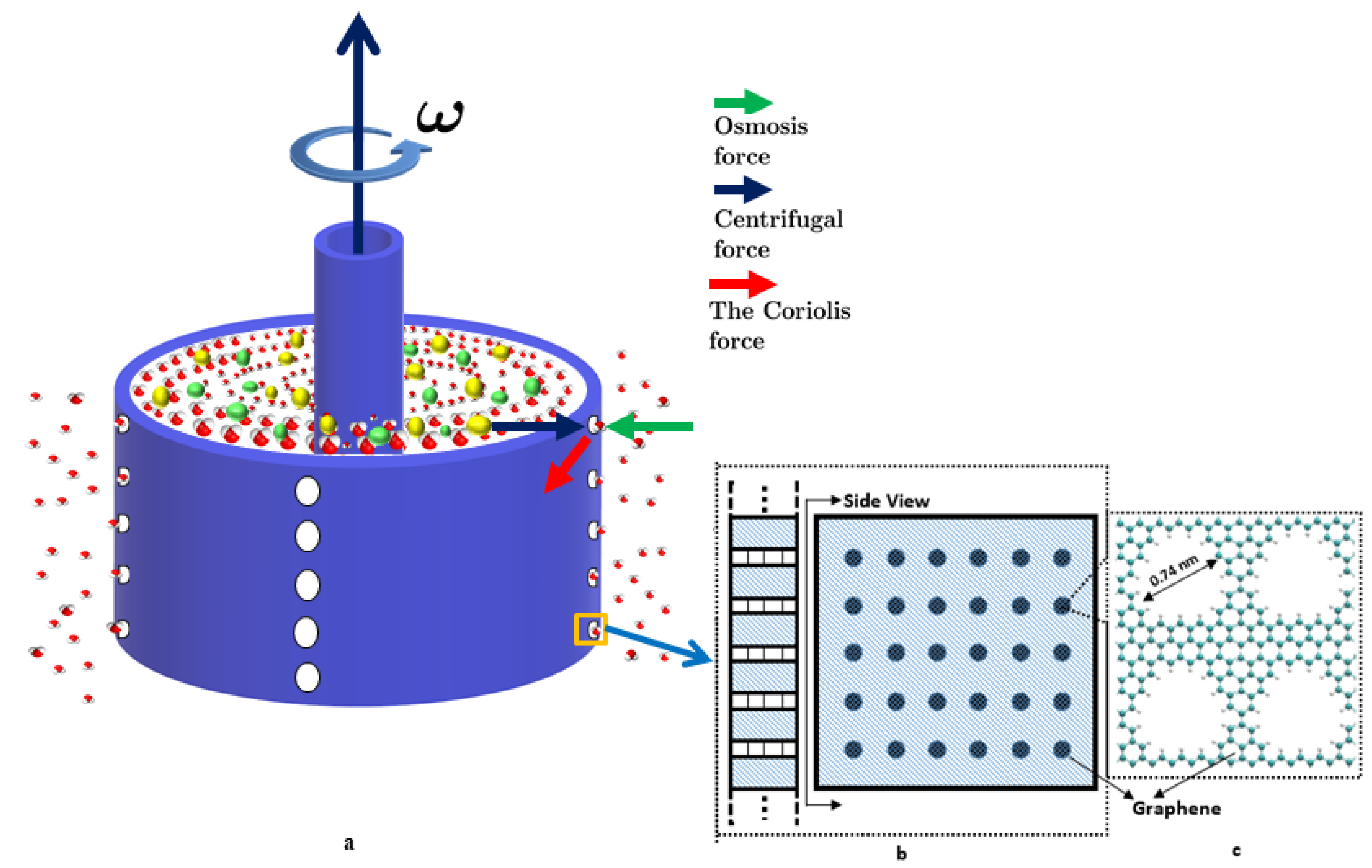
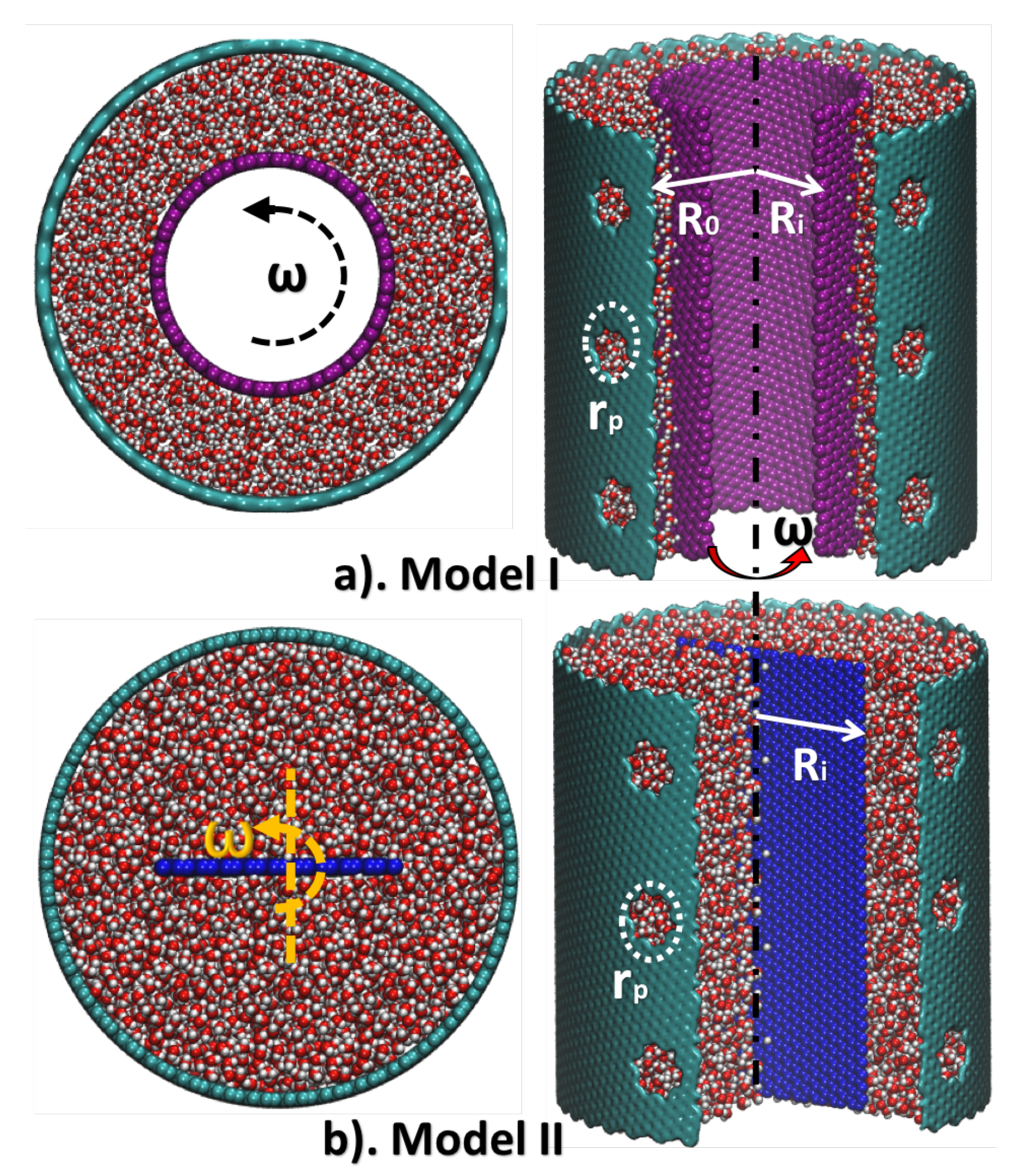

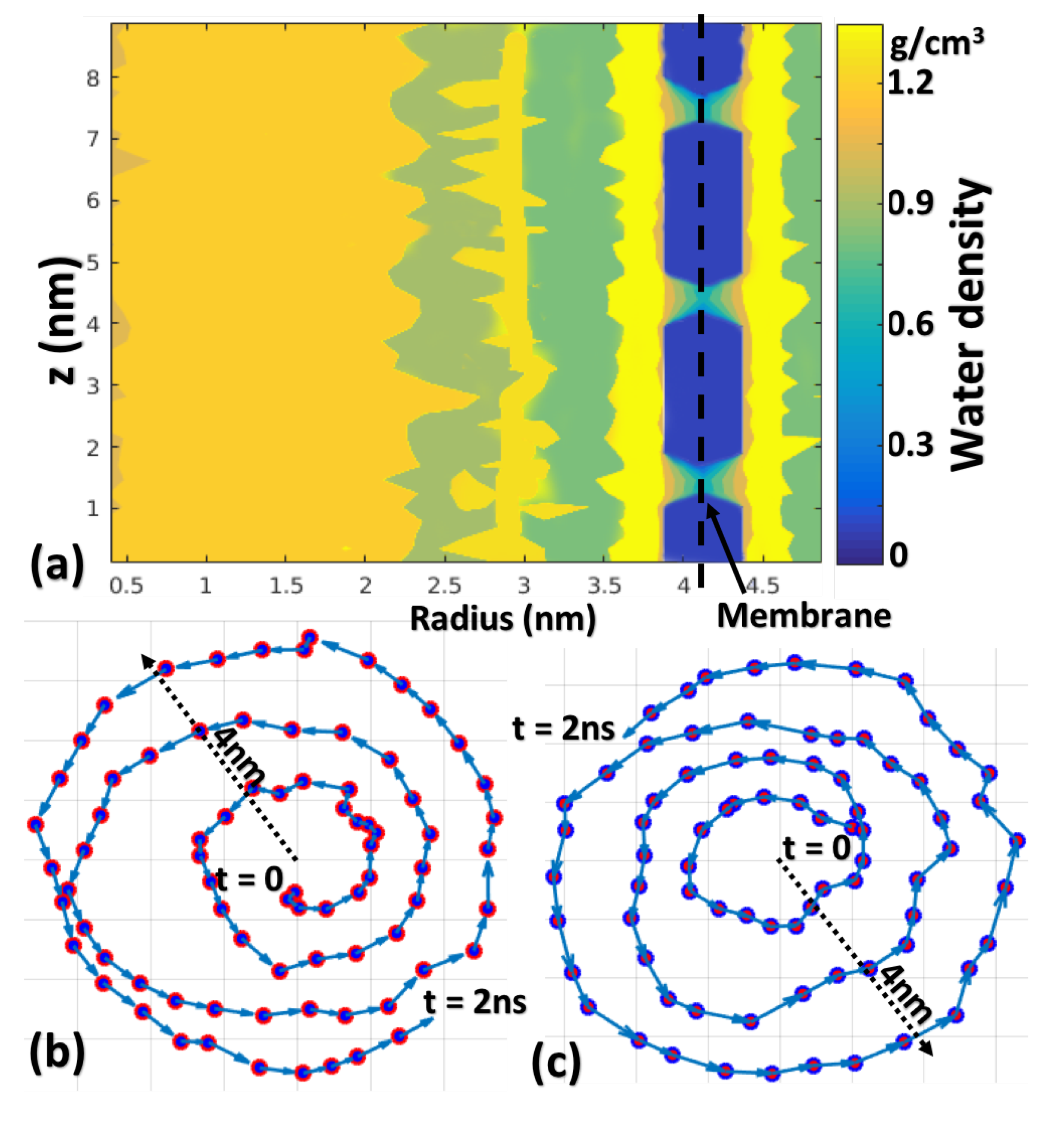
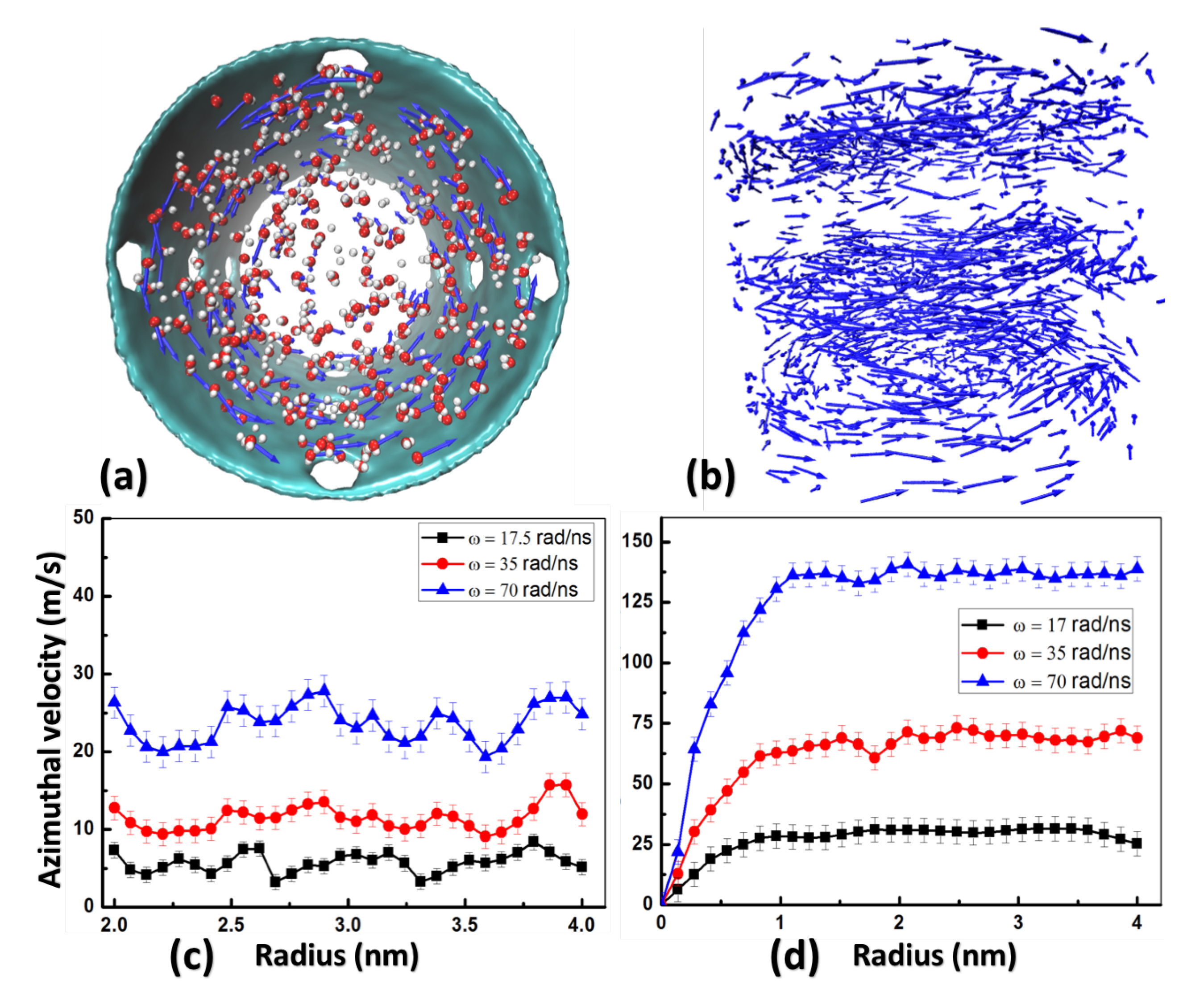
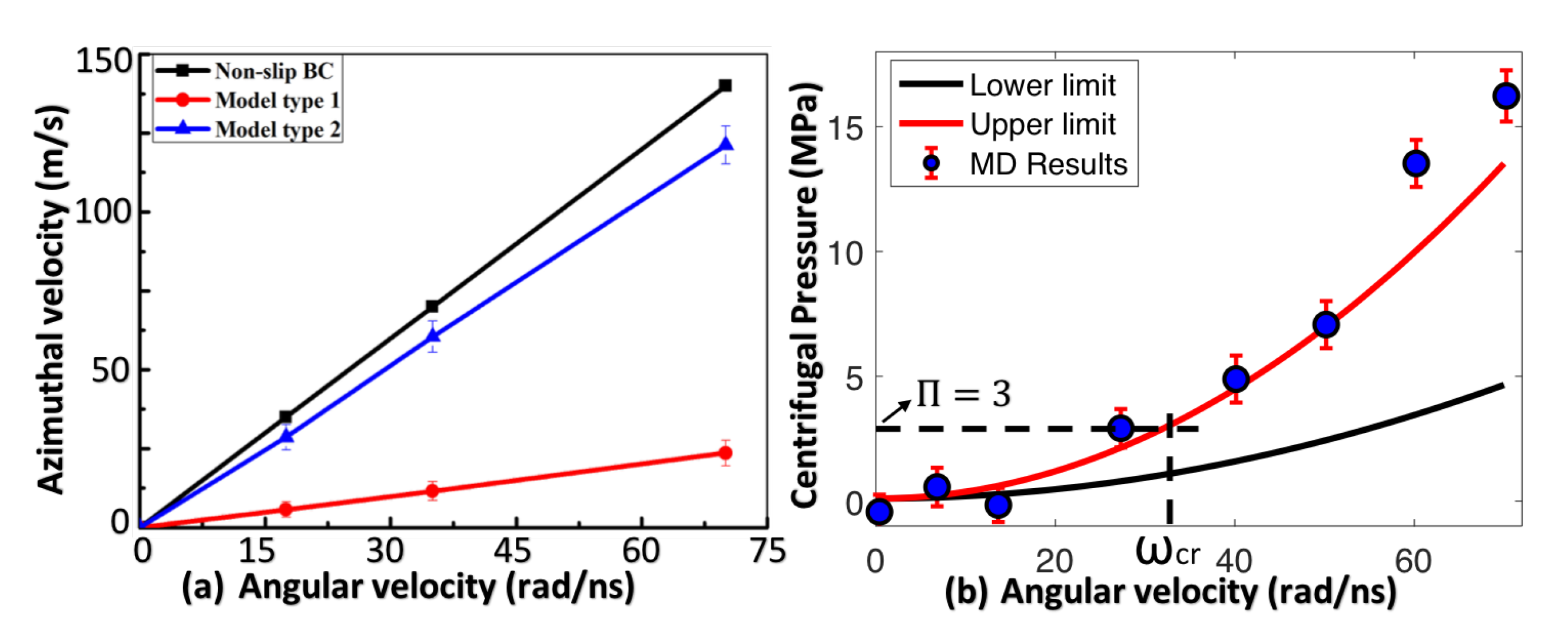
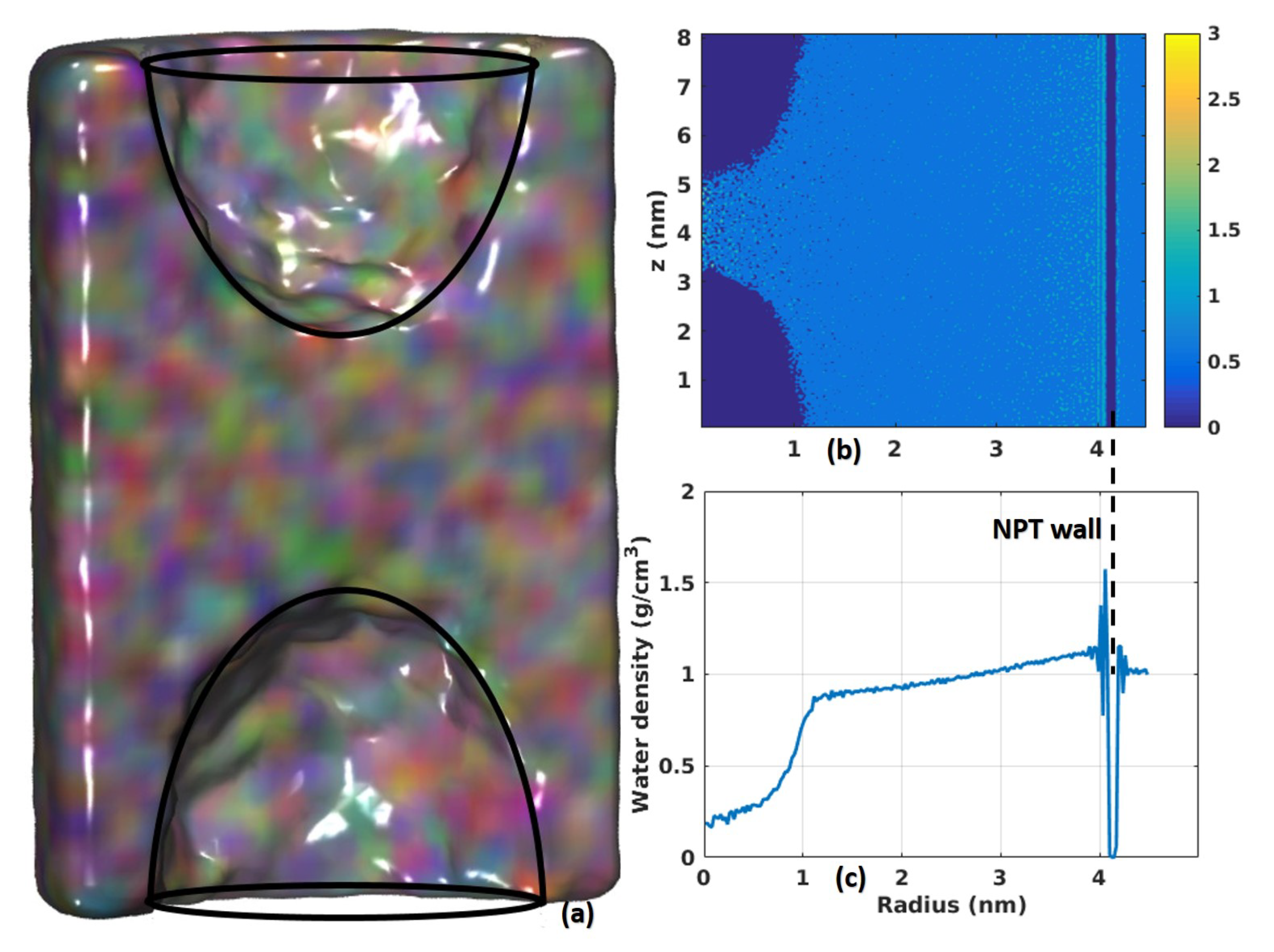
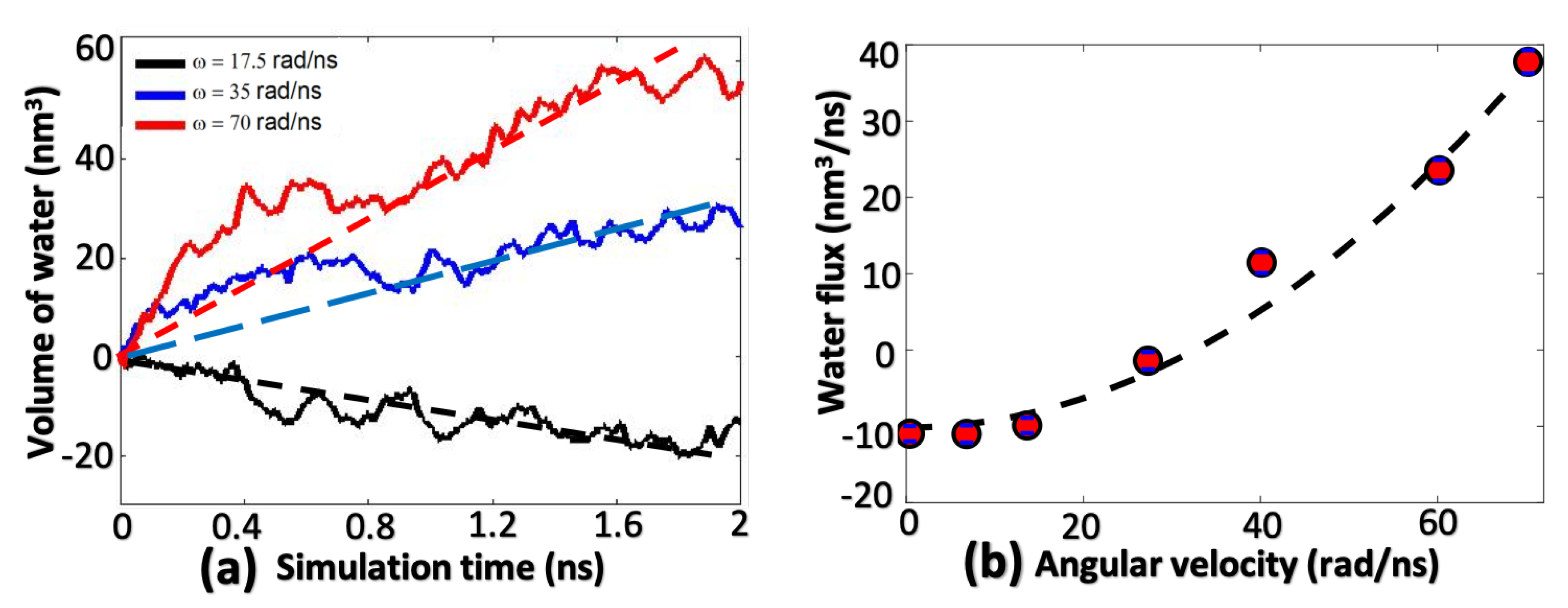
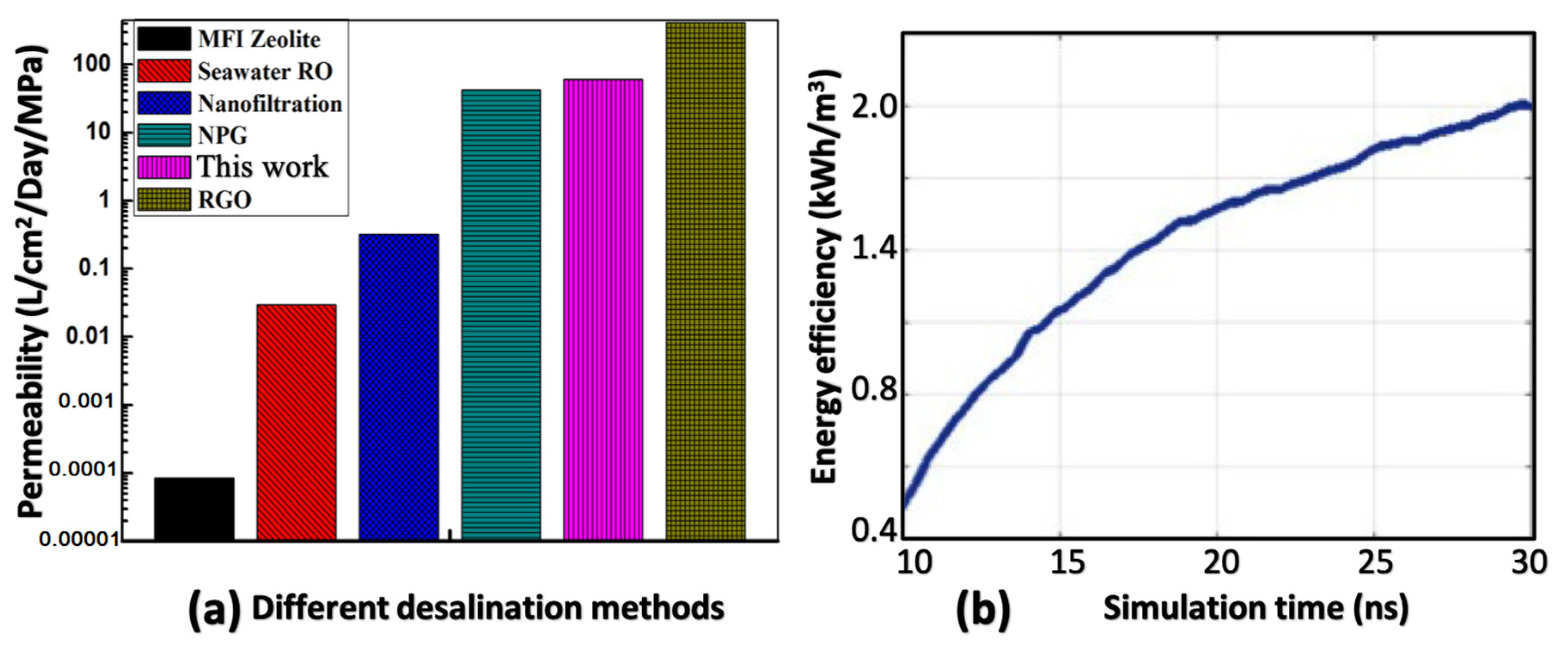
© 2020 by the authors. Licensee MDPI, Basel, Switzerland. This article is an open access article distributed under the terms and conditions of the Creative Commons Attribution (CC BY) license (http://creativecommons.org/licenses/by/4.0/).
Share and Cite
Tu, Q.; Ibrahimi, W.; Ren, S.; Wu, J.; Li, S. A Molecular Dynamics Study on Rotational Nanofluid and Its Application to Desalination. Membranes 2020, 10, 117. https://doi.org/10.3390/membranes10060117
Tu Q, Ibrahimi W, Ren S, Wu J, Li S. A Molecular Dynamics Study on Rotational Nanofluid and Its Application to Desalination. Membranes. 2020; 10(6):117. https://doi.org/10.3390/membranes10060117
Chicago/Turabian StyleTu, Qingsong, Wice Ibrahimi, Steven Ren, James Wu, and Shaofan Li. 2020. "A Molecular Dynamics Study on Rotational Nanofluid and Its Application to Desalination" Membranes 10, no. 6: 117. https://doi.org/10.3390/membranes10060117
APA StyleTu, Q., Ibrahimi, W., Ren, S., Wu, J., & Li, S. (2020). A Molecular Dynamics Study on Rotational Nanofluid and Its Application to Desalination. Membranes, 10(6), 117. https://doi.org/10.3390/membranes10060117






